Locally Owned and Operated
Park City's Premier Pest Control Service
Locally Owned and Operated
Park City's Premier Pest Control Service
Child and Pet Friendly
Recurring Maintenance Plans
Customized Plans to Meet Your Needs
Rodent Control
We Locate and Seal up Rodent Entry Points
Servicing all General Pests
Ants (Including Carpenter Ants), Spiders, Rodents, and Beetles
Professional
Friendly | Safe | Reliable | On-time
Live Local Buy Local
" At Quality Care Pest Control, we don't just treat rodent problems, we stop them at the source. We specialize in sealing up your home's exterior to block entry points and keep rodents out. "
Testimonials
Here's What Our Clients Think About Quality Care Pest Control
I was having a MAJOR yellow jacket problem. My wife and I have two little ones and two dogs. These yellow jackets were nesting EVERYWHERE. We couldn't let the kids go outside by themselves. Jon came and sprayed around our home. It only took him 20-30 minutes, and presto! By the next day, we didn't have a problem anymore. I highly recommend Quality Care Pest Control. Very professional, and they know their bugs.
We are thrilled with Jon and Quality Care Pest Control. He resolved our rodent issue, which had been made much worse by our previous service. Jon is knowledgable, thoughtful and takes great pride in his work. I would highly recommend him to anyone. He is worth every penny if you want to resolve your pest problems!
Mice no more! Quality Pest Control answered my call promptly and set up a service appointment the next day. Jon, the service tech was on time and gave a thorough assessment of our mouse and vole problems and honestly answered all our questions regarding exterior containment. We started service two weeks ago he sealed the house and we haven’t had any inside since which makes us very happy.
Our first service was today and we couldn't be happier! Jon is very easy to talk to, thorough, and loved our dogs, that makes him even better in our books
Quality Care Pest Control did an amazing job. We recently purchased a 20 year old cabin in Oakley with evidence of rodent issues. Jon came out and sealed up our cabin. He found every nook and cranny a rodent could enter and made sure it was sealed and that it looked good as well. I could tell he really takes pride in his work and in getting things done right the first time. He continued to come back for a few weeks to check for any activity for what may have been left in the cabin. Start to finish, Jon was great. If we ever have any new issues going forward, he will be the guy I call.
I work with a large property management company in Park City. We have contracted Quality Care Pest Control for over 5 years. They are always on time, professional, and put your health and safety first. I also use QCPC for my personal residential home. Jon is a joy to work with and won't let you down. I had a mouse issue; that was diagnosed and mitigated immediately. Their specialized services really put Quality Care Pest Control above and beyond the competition! Thanks again to Jon and his Team!
Jon helped with our hornet problem and then went above and beyond when a baby skunk made its way into our kitchen! He was taking care of the Hornets at the time the skunk came in and he was sweet enough to help lead the baby skunk out of our house without it spraying! Lucky for us he was there!
Jon does my pest control and he is the best I have found! He listens to my concerns about potential harm to other animals and birds then acts accordingly. Very dependable…and knowledgeable.
Quality Care Pest Control has been amazing! Jon is the ONLY company that has solved our pest situation! He is a great man and very knowledgeable about his business. Thanks, Jon, not sure what we would do without him!
I actually own a pest control company as well but the only person I refer business to when I can't do it is to Jon with Quality Care Pest Control. He knows his stuff and is very personable.
I’ve used Quality Care Pest Control for many years and will not use anyone else. They have excellent customer service, are knowledgeable, punctual, and reliable! Every service has been successful. Highly recommend!
Jon was great. Could tell he knows his stuff. Very quick response time. Sealed up my home and haven’t had mice ever since.
I’ve used quality care multiple times (two different properties). Jon is extremely prompt, knowledgeable and professional and is fully equipped to deal with any pest problem. Highly recommend quality care.
Professional, friendly and fixed the problem
I have been a satisfied Quality Care Pest Control customer since 2022. I called them to come out for a preventive rodent proofing evaluation, not knowing that I had an existing problem. Jon (owner) personally sealed up all potential exterior entry points and strategically placed mouse traps inside our home. Sure enough we caught the culprit the next morning. Jon really knows his stuff. 100% satisfied!
Man, what can I say about Jon Duda… What a person!!! I had been through 5 pest control companies trying to resolve my mouse issue! None of them made any improvements. A friend of mine told me about Jon and his company. I had him come out to inspect. I was amazed at how detailed his inspection was and how he took his time scanning every inch of my home. He came up with a solution that made total sense to me! So I decided to give him a shot. And boy, am I glad I did! Not only did he seal up all the entry points, but he made it look like he had never been there! His attention to detail is unmatched!! And I’m happy to say I HAVE NO MICE!! Jon was so professional and very personable!! I would recommend him and his company to anyone!!!
Learning Center
Spiders
At Quality Care Pest Control, we specialize in identifying and eliminating all types of spiders, dangerous or not. Whether you’re dealing with an active infestation or want peace of mind, we’ve got you covered.
Spiders are easily recognized by their eight legs and two-part body structure. With tens of thousands of species found worldwide, most are harmless and even beneficial. However, several species are common in Utah, but only a few are considered dangerous to humans, including the black widow and hobo spider. Spider Control in Park City & Summit County, Utah.
Common Spiders Species:
Black and Brown Widow Spiders (Latrodectus mactans)

Black and brown widows are part of the cobweb spider family, known for creating messy, irregular webs made of strong, sticky silk. These spiders are often found in undisturbed areas around homes, garages, sheds, and outdoor furniture.
The female black widow is easily recognized by her shiny black body and distinctive red hourglass marking on the underside of her abdomen. Brown widows are slightly less intimidating in appearance, with tan or brown coloring, striped legs, and an orange hourglass marking. While brown widow bites are rarely serious, the black widow’s venom is more potent and may require medical attention. Fortunately, male and juvenile widows are generally harmless.
Widow spiders are common in Park City and Summit County, Utah. If you’re seeing webs in dark corners or suspect widow activity around your home, don’t wait.
Call Quality Care Pest Control today to safely eliminate widow spiders and protect your home—inside and out.
Hobo Spider (Tegenaria agrestis)
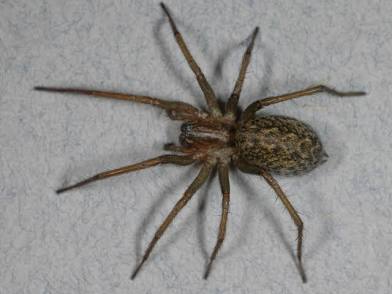
The hobo spider is a member of the funnel-web weaver family, known for building flat, layered webs with a distinctive funnel-shaped retreat where the spider hides and waits for prey. Unlike traditional sticky webs, hobo spider webs are trip webs, designed to ensnare insects that stumble across their surface.
These spiders are fast movers and moderately large, with adult body lengths ranging from 12–18 mm. Their long legs lack markings, and their abdomen typically shows a “herringbone” or chevron pattern. With legs extended, a hobo spider can span roughly the size of a silver dollar.
While hobo spiders are not aggressive, their bites can be venomous. The most commonly reported symptom is a severe headache, but others may include nausea, fatigue, temporary memory loss, or vision disturbances. Though bites are rare, it’s important to treat potential infestations seriously.
Hobo spiders are commonly found:
- Around foundations of homes
- Beneath rocks, woodpiles, and yard décor
- In basements, crawl spaces, or undisturbed areas
If you suspect hobo spider activity, call Quality Care Pest Control today. We’ll inspect your home, identify problem areas, and help you gain control of pests, inside and out.
Brown Recluse Spider (Loxosceles reclusa)
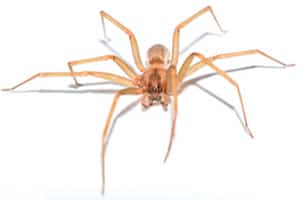
The brown recluse is easily identified by the distinctive violin-shaped marking on its back, which gives it its nickname. True to its name, this spider is reclusive, preferring dark, undisturbed areas both indoors and out. Common hiding spots include under porches, deep closets, basements, trash cans, tires, and other secluded locations where prey may wander.
Brown recluses are primarily nocturnal and typically lay eggs between May and July. Though not aggressive, they are venomous, and their bite can cause a range of reactions depending on how much venom is injected and the person’s sensitivity. Symptoms can vary from mild irritation to serious skin lesions and, in rare cases, systemic effects such as fever, fatigue, or nausea.
While not native or common in Utah, brown recluse spiders have occasionally been found in and around homes in Park City and Summit County but are mostly brought in by imports or moving boxes from warmer states.
If you suspect a brown recluse or any spider activity near your home, don’t take chances.
Call Quality Care Pest Control today for a professional inspection and customized treatment plan.
Ants
Ants are one of the most persistent household pests. Whether they’re contaminating your food, damaging wood, or forming large colonies inside your home, ants can quickly become a serious problem. At Quality Care Pest Control, we identify the specific species and implement targeted solutions to eliminate infestations at the source. Ant Control in Park City & Summit County, Utah.
Common Ants Species:
Carpenter Ants
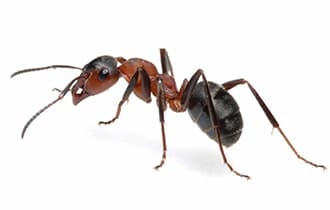
Carpenter ants are large, ranging in size from 1/4 inch to 1 inch. While they don’t eat wood, they chew through it to create nesting galleries, which can lead to structural damage over time.
- Commonly black or reddish-brown in color
- Prefer to nest in dead, damp wood
- Leave behind sawdust-like material, often near baseboards or windows
- Can produce a humming or rustling noise when active—an indication of a large infestation
- The most common species in Utah is the Black Carpenter Ant
Pavement Ants
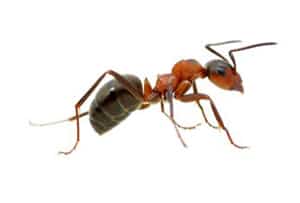
Pavement ants are small about 1/8 inch long and are dark brown to blackish in color. As their name suggests, they typically travel through cracks in pavement, sidewalks, and foundation slabs.
- Often found indoors around baseboards, kitchens, and entry points
- Feed on a wide range of foods including meats, grease, insects, seeds, and honeydew from aphids
- Known to contaminate food and should be treated promptly
Little Black Ants
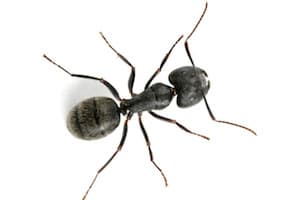
Little black ants are among the smallest household ants. Workers measure approximately 1/16 inch, and queens are about 1/8 inch in length. They are shiny black and move in clearly defined trails.
- Commonly found in kitchens, bathrooms, laundry rooms, and other moisture-prone areas
- Known to form multiple colonies with multiple queens
- Eggs can hatch in as little as 10 days, allowing infestations to grow rapidly
- Their rapid reproduction makes them more difficult to eliminate than other ant species
If you’re seeing ants in your home, don’t wait for the problem to get worse.
Contact Quality Care Pest Control today for expert ant control in Park City and Summit County, Utah and get reliable protection inside and out.
Rodents
Rodents pose more than just a nuisance, they can be a serious health risk. Rats and mice are known carriers of several dangerous diseases that can be transmitted to humans directly or indirectly.
Rodents are more than just a pest, they’re a potential health threat.
If you suspect rodent activity around your home in Park City or Summit County, Utah, contact Quality Care Pest Control today for a thorough inspection and safe, effective treatment.
Diseases Transmitted by Rodents:
Diseases Directly Transmitted by Rodents:
-
Hantavirus Pulmonary Syndrome (Virus)
Spread by:- Inhaling dust contaminated with rodent urine or droppings
- Direct contact with rodent feces or urine
- Bites from infected rodents
-
Leptospirosis (Bacteria)
Spread by:- Drinking water or eating food contaminated with urine from infected animals
- Skin or mucous membrane contact with contaminated water or soil
-
Rat-Bite Fever (Bacteria)
Spread by:- Bites or scratches from infected rodents
- Handling dead rodents
- Consuming food or water contaminated by rat feces
Diseases Indirectly Transmitted by Rodents:
-
Plague (Bacteria)
Spread by:- Bites from infected fleas
- Direct contact with infected rodents
Common Rodents Species:
Mice
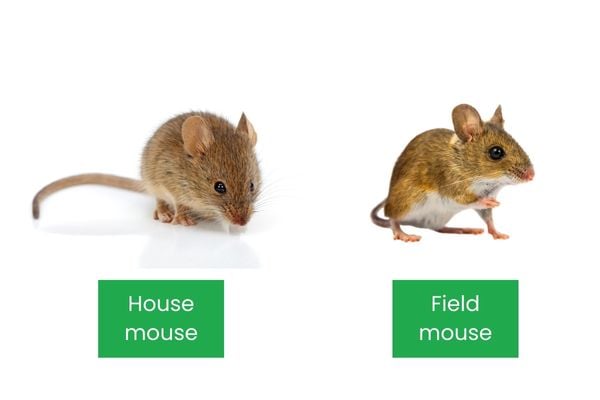
Mice Control & Exclusion
At Quality Care Pest Control, we specialize in rodent exclusion services, sealing up your home to prevent mice from getting in. A thorough inspection is necessary to accurately identify entry points and provide a reliable quote for sealing your home against future infestations.
Why Mice Are a Problem
Mice are incredibly well adapted to indoor living and are especially common in the fall and winter months, as they seek warmth, food, and shelter. Once inside, they reproduce rapidly, producing 6 to 10 litters per year, making early detection and control critical.
Common Mice in Utah
- House Mouse
- Deer Mouse
- Field Mouse
Health Risks
Despite their size, mice pose serious health risks. Their droppings, urine, and saliva can carry and spread a variety of dangerous diseases, including:
- Hantavirus Pulmonary Syndrome
- Hemorrhagic Fever with Renal Syndrome
- Leptospirosis
- Lymphocytic Choriomeningitis (LCM)
- Rat-Bite Fever
- Salmonellosis
How Mice Enter Your Home
Mice can squeeze through openings as small as 1/4 inch, about the size of a dime. Common entry points include:
- Gaps in siding or foundations
- Utility line penetrations
- Garage and crawl space doors
- Unsealed windows, doors, and vents
If you’ve seen signs of mice, or want to prevent them before they become a problem, call Quality Care Pest Control in Park City & Summit County, Utah today.
We’ll inspect your home and create a customized plan to protect your space inside and out.
Voles
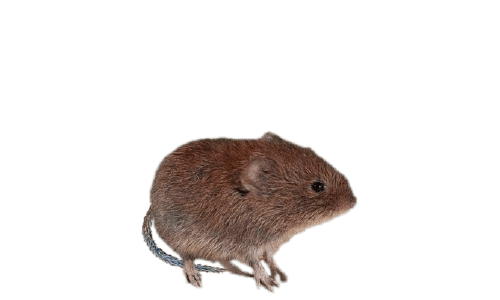
Vole Control
Voles are small, burrowing rodents that may resemble mice but behave very differently. Unlike mice, voles are herbivores, feeding primarily on grass roots, bulbs, and other vegetation. Their feeding habits can cause extensive damage to lawns, gardens, and landscaping.
How Voles Damage Your Yard
Voles create visible “runways” or “highways” in your grass by repeatedly traveling the same paths. This constant traffic flattens the grass and forms tunnel-like trails. They also dig multiple burrow entrances to their dens and often build small nests out of dead grass beneath the snow during winter.
Because voles do not hibernate, most of the damage occurs in the winter months when snow provides cover from predators. Homeowners typically discover the destruction in early spring once the snow melts.
Reproduction & Infestation Risk
Voles reproduce rapidly:
- Gestation period: ~24 days
- Litter size: 4 to 11 young
- Sexual maturity: As early as 10 days old
How We Control Voles
At Quality Care Pest Control, we use anticoagulant rodent baits placed inside tamper-resistant bait stations. These stations are:
- Designed specifically for rodent access only
- Bait is securely fastened inside
- Staked into the ground using 10-inch stakes to prevent tampering or movement
Vole Identification
Although they resemble mice, voles can be distinguished by:
- Short tails
- Blunt faces
- Small digging claws
If you notice runways in your yard or suspect vole activity, don’t wait for the damage to spread.
Call Quality Care Pest Control today for professional vole control in Park City and Summit County, Utah and reclaim your lawn before it’s too late.
Red Squirrels
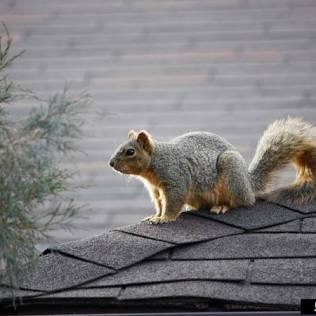
Red Squirrel Control in Park City & Summit County, Utah
Red squirrels may look cute, but when they move into your attic, garage, or crawl space, they can become a major nuisance, and a source of serious damage. These highly territorial rodents are smaller than other tree squirrels but make up for it with aggressive behavior and relentless chewing habits.
Why Red Squirrels Are a Problem
Red squirrels are known for getting into roofs, attics, soffits, and wall voids. Once inside, they can cause:
- Chewed electrical wires (a fire hazard)
- Destroyed insulation used for nesting
- Contaminated storage areas with urine and droppings
- Noise disturbances, especially in the early morning
Nesting & Behavior
Red squirrels typically:
- Nest in tree cavities, attics, or wall voids
- Hoard pinecones, nuts, and other food sources inside their dens
- Defend their territory fiercely, often pushing out other animals
- Remain active year-round, especially noticeable in colder months when they seek warmth indoors
Reproduction & Infestation Potential
- Breeding season: Early spring and late summer
- Litters: 3–7 young
- Two litters per year are common
Our Red Squirrel Control Approach
At Quality Care Pest Control, we focus on humane, effective exclusion and eviction methods to remove red squirrels and prevent future activity.
Our service includes:
- A detailed roof and exterior inspection to identify entry points
- Installation of one-way doors that allow squirrels to exit but not return
- Exterior exclusion work to seal vulnerable areas on the roofline or siding
- Recommendations for tree trimming or other access prevention strategies
If you’re hearing scratching, chewing, or thumping in your attic, it could be red squirrels.
Call Quality Care Pest Control today for expert red squirrel removal and exclusion services in Park City and Summit County, Utah and protect your home from top to bottom.
Pack Rats
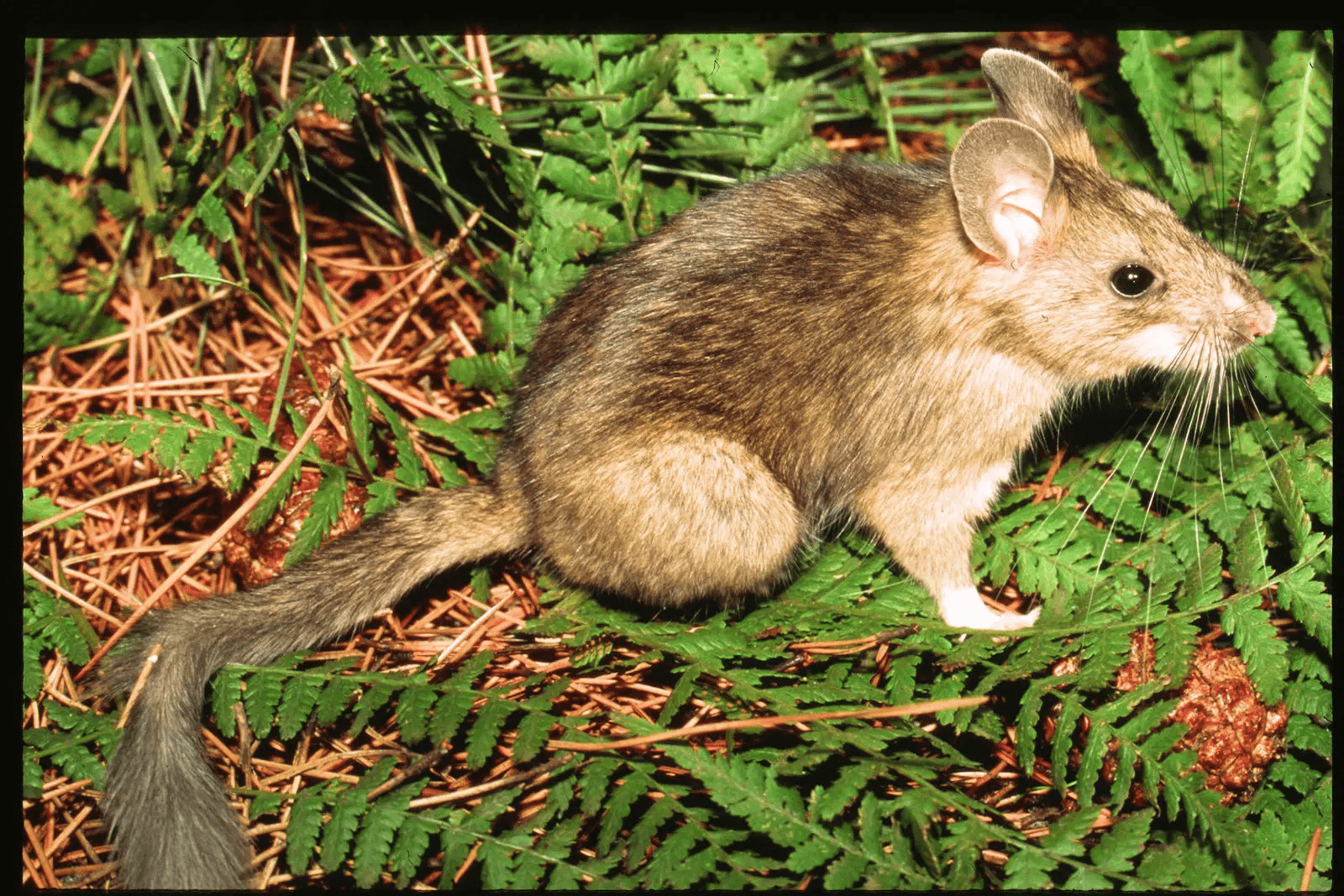
Pack Rat Control
Pack rats, also known as woodrats, are large, nocturnal rodents known for their destructive nesting behavior and tendency to collect shiny or miscellaneous objects—hence the name “pack” rat. While they may seem harmless at first, pack rats can cause serious damage to homes, vehicles, insulation, wiring, and stored belongings.
What Makes Pack Rats a Problem
Pack rats are solitary nesters, often building large, messy nests (called middens) made of sticks, leaves, insulation, and debris. They commonly nest:
- In attics, garages, crawl spaces, and sheds
- Under decks, in rock walls, or in woodpiles
- Inside vehicles (especially during colder months)
Health Risks of Pack Rats
Pack rats can carry and spread diseases such as:
- Hantavirus Pulmonary Syndrome
- Leptospirosis
- Salmonellosis
- Plague (transmitted by fleas they may carry)
Reproduction & Infestation Potential
Pack rats are prolific breeders:
- Breeding season: Spring through late summer
- Litters: 1–5 young per litter
- Multiple litters per year
Our Pack Rat Control Approach
At Quality Care Pest Control, we use a combination of exclusion, trapping, and baiting to eliminate pack rats and keep them from returning.
Our process includes:
- A thorough inspection to identify nesting sites and entry points
- Exclusion work to seal up gaps, vents, and other access points
- Rodent bait stations (tamper-resistant and secured) placed in high-activity areas
- Safe, humane trapping if needed inside attics, garages, or crawl spaces
If you’re hearing noises at night, finding shredded materials, or noticing rodent droppings, pack rats may be the cause.
Call Quality Care Pest Control for expert pack rat removal in Park City and Summit County, Utah and let us help protect your home inside and out.
Cockroaches
Cockroaches are among the most reviled household pests, and for good reason. They carry numerous pathogens, contaminate food, and can trigger allergic reactions and asthma attacks, especially in children. These insects are highly adaptable, extremely resilient, and once an infestation takes hold, professional treatment is essential for complete elimination. At Quality Care Pest Control, we specialize in identifying infestation sources and using targeted treatments to eliminate cockroaches for good.
Why Cockroaches Are Dangerous:
- Known to spread 33 types of bacteria, including E. coli and Salmonella
- Can transmit 6 parasitic worms and over 7 types of human pathogens
- Cockroach droppings, saliva, and shed skins contain proteins that trigger asthma and allergies
- Contaminate food and surfaces with malodorous secretions and disease-causing organisms
- Feed on nearly any organic material, including decaying matter, grease, glue, and crumbs
Behavior:
Roaches thrive in warm, moist environments and often hide in cracks, crevices, behind appliances, and inside cabinets, making them difficult to detect until the infestation is severe.
Common Cockroaches Species:
German Cockroaches (Blattella germanica)
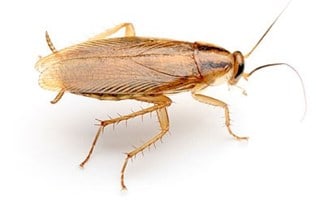
The German cockroach is the most common species found in homes, apartments, restaurants, and commercial kitchens. They are tan to light brown, measuring between 1/4 to 3/4 inch in length. Though winged, they do not fly.
- Known to spread bacteria, viruses, and protozoans that cause dysentery, diarrhea, and food poisoning
- Secrete foul-smelling compounds that taint food and surfaces
- Leave behind shed skins and fecal smears, both of which are strong allergens
- Hide in tight cracks and crevices, often near heat and moisture sources (kitchens and bathrooms)
- Nocturnal and extremely fast, often hiding before they’re noticed
- Females carry egg cases (oothecae) until hatching, protecting the next generation and increasing population rapidly
If you’re seeing cockroaches—or even just signs of them—it’s time to act fast.
Contact Quality Care Pest Control today for expert cockroach control in Park City and Summit County, Utah—and take back your home with confidence.
Beetles
Beetles and related pests can become a significant nuisance in Park City and Summit County, Utah, especially during seasonal migrations into homes. Whether it’s boxelder bugs staining walls, Asian lady beetles invading by the thousands, or carpet beetles damaging fabrics, Quality Care Pest Control offers expert inspection, treatment, and prevention to keep your home protected year-round.
Common Beetles Species:
Boxelder Bugs

Boxelder bugs are often mistaken for beetles due to their oval-shaped, black bodies with reddish-orange markings on their back. They are closely associated with boxelder and maple trees, where they lay eggs and feed on leaves, flowers, and seed pods during the warmer months.
- Commonly found on boxelder, maple, and occasionally apple or plum trees
- Most active in late summer and fall
- Tend to gather in large groups on the sunny, south-facing sides of buildings, rocks, or trees
- In autumn, they migrate to nearby homes to overwinter
- Enter through cracks, vents, or siding gaps, hiding in wall voids, attics, and crevices
- Become active again in late March to early April, returning to trees as temperatures rise
Although they do not bite or cause structural damage, boxelder bugs can stain walls and fabrics with their droppings and become a major nuisance when they gather indoors.
Asian Lady Beetles
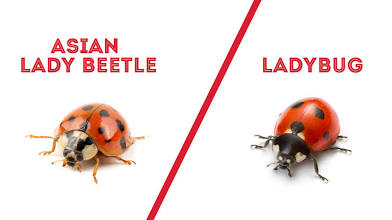
Asian lady beetles closely resemble the familiar red-and-black spotted ladybug, but unlike their native counterparts, they are invasive, aggressive, and capable of infesting homes by the thousands.
- Vary in color from light orange to deep red with black spots, but not always uniform
- Distinctive black “M” or “W” shaped marking on the area behind their head
- Most active in fall, especially on warm, sunny days
- Congregate on south- and west-facing walls before entering homes to overwinter
- Often found in attics, wall voids, window frames, and light fixtures
- Can emit a foul odor and leave behind yellow staining secretions when disturbed or crushed
- Known to bite, though not harmful, and can cause minor allergic reactions in sensitive individuals
Asian lady beetles are not the same as native ladybugs; they’re invasive, unpleasant, and unwanted guests inside your home.
Carpet Beetles
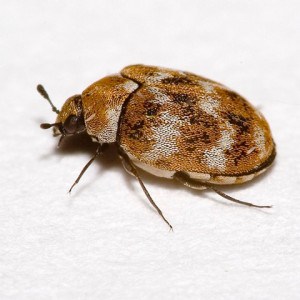
Carpet beetles are destructive household pests that target natural fibers, including wool, silk, fur, and leather. While adult carpet beetles feed on pollen and nectar, their larvae are the real threat, capable of damaging clothing, carpets, upholstery, and stored goods.
Important:
Carpet beetles will never be fully eliminated unless the source of the infestation is identified and removed. In many cases, we find the source to be spoiled food stashed by rodents in wall voids or hidden areas, creating the perfect environment for carpet beetles to thrive.
Carpet beetle infestations are commonly linked to rodent activity, and the home may require rodent exclusion or sealing to prevent future reinfestation.
- Larvae feed on wool, fur, silk, feathers, leather, and dead insects
- Prefer dark, undisturbed areas like closets, under furniture, and in air ducts
- Larvae do not spin webs like clothes moths but leave behind shed skins and fecal pellets (often mistaken for salt grains)
- May burrow into materials to pupate or hide within their final larval skin
- Adults do not damage fabric, instead feeding on flower pollen and nectar
- Attracted to sunlight, often seen near windows or light fixtures
- Resemble small, rounded lady beetles, but are smaller with shorter antennae
One of the most common species found indoors, the varied carpet beetle is about 1/10 inch long and easily recognized by its mottled pattern of white, brown, and dark yellow scales on its back.
- Indoors, eggs are laid on or near wool carpets, silk, fur, stuffed animals, and dried plant materials
- Adult beetles emerge in spring and early summer, often found near windows as they try to get outdoors
- A single female can lay dozens of eggs, leading to widespread damage if left untreated
If you notice large groups of boxelder bugs on your home or property, especially in the fall it’s time to act.
If you’re seeing swarms of beetles gathering on your siding or windows, act before they move in.
If you’re finding small beetles near windows, signs of textile damage, or suspect hidden rodent activity, carpet beetles may be to blame.
Contact Quality Care Pest Control for reliable beetle and boxelder bug control in Park City and Summit County, Utah and keep your home protected year-round.
Wasps
Wasps are a common warm-season pest in Utah and can pose a serious risk due to their painful stings, aggressive behavior, and tendency to nest near homes. While wasps cannot be stopped from foraging or flying through your yard, they are often drawn to human activity, especially when food, alcohol, or sugary drinks are present. They are particularly attracted to proteins and fermented substances, which means outdoor dinners, barbecues, and drinks on the porch can quickly become a magnet for unwanted stinging pests. Whether you’re dealing with yellow jackets, paper wasps, or mud daubers, Quality Care Pest Control provides expert inspection, removal, and prevention services to protect your home and family.
Common Wasps Species:
Yellow Jackets
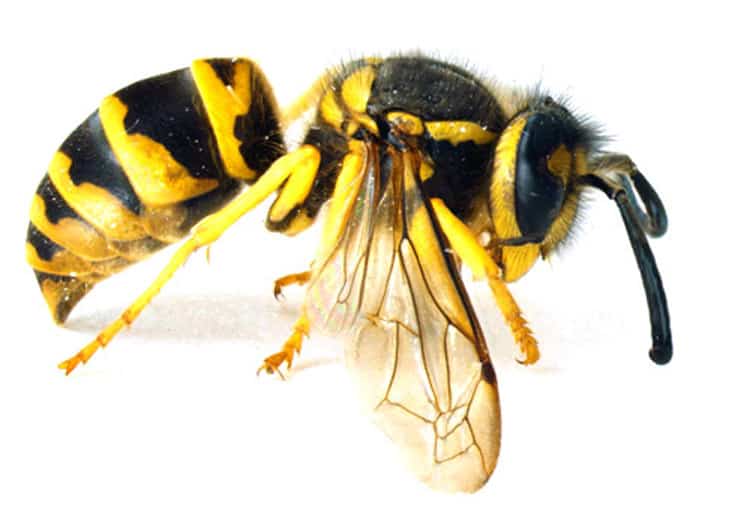
Yellow jackets are highly aggressive wasps that can sting multiple times and will do so without provocation. They are often mistaken for bees due to their bright yellow and black coloration, but they are far more defensive and dangerous, especially when their nest is disturbed.
- Nests commonly built underground, in trees, attics, between walls, or under eaves
- Nest entrances are small and difficult to spot, often the size of a quarter
- Forage for food within 1,000 feet of their nest
- Known to bite and sting (they often bite to secure a grip before stinging)
- Do not lose their stinger, allowing them to sting multiple times
- Swarm attacks may occur when a nest is accidentally disturbed
- In fall, inseminated females seek indoor shelter, often entering through high ceilings or attic vents
Paper Wasps
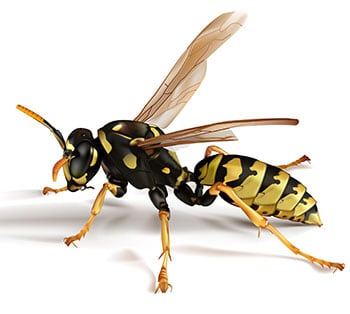
Paper wasps are less aggressive than yellow jackets but will sting when threatened. Their slender black and yellow bodies and umbrella-shaped nests help distinguish them.
- Build nests in trees, under eaves, inside attics, or between walls
- Feed on nectar and insects like flies and caterpillars
- Painful sting can cause allergic reactions
- In late fall, inseminated females seek shelter indoors to overwinter, especially in homes with vaulted ceilings
Mud Daubers
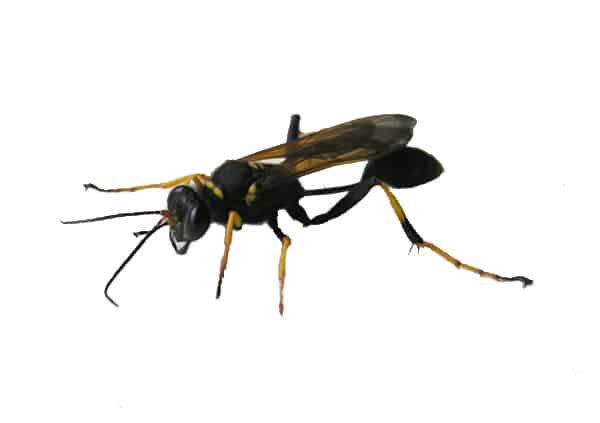
Mud daubers are solitary wasps and not aggressive. These wasps rarely sting and are generally considered beneficial, as they help control spider populations by paralyzing and feeding them to their larvae.
- Construct nests of mud tubes, usually 1” long, often in eaves, garages, barns, attics, or sheds
- Nests consist of clusters of short mud tubes placed side by side
- Abandoned nests often show small round holes where adult wasps have emerged
- Do not defend their nests, and stings are rare
- Considered nuisance pests, but beneficial in the ecosystem
If you’ve spotted a wasp nest or are experiencing increased wasp activity, don’t take chances.
Contact Quality Care Pest Control today for safe, effective wasp control in Park City and Summit County, Utah—and take back your yard, porch, and peace of mind.
Services
- Exclusion (seal up exterior of home)
- Mice Trapping
- Seasonal
- Prevent Roof Top Entry
- Seal Critter Entrances
- Seasonal
One-Time
Treatment for Insects
- Safe for Children
- Safe for Pets
- One-time Service
Contact
Get in Touch With a Quality Care
Pest Control Representative

